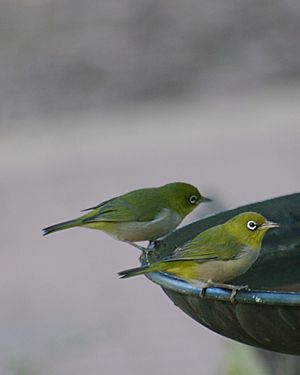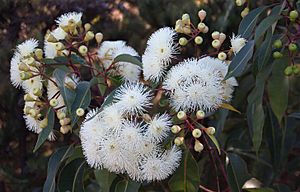Western silvereye facts for kids
Quick facts for kids Western silvereye |
|
|---|---|
 |
|
| Western silvereyes at Ngilgi Cave, Western Australia | |
| Scientific classification |
|
| Kingdom: | Animalia |
| Phylum: | Chordata |
| Class: | Aves |
| Order: | Passeriformes |
| Family: | Zosteropidae |
| Genus: | Zosterops |
| Species: | |
| Subspecies: |
Z. l. chloronotus
|
| Trinomial name | |
| Zosterops lateralis chloronotus Gould, 1841
|
|
| Synonyms | |
|
|
The western silvereye (Zosterops lateralis chloronotus) is a small, greenish bird. It belongs to the Zosteropidae family, also known as the White-eye family. This bird is a type of silvereye found in Western Australia and South Australia. People sometimes call it the white-eye or greenie because of its color. In some Australian Aboriginal languages, it is known as jule-we-de-lung or julwidilang around Perth. Another name for it is poang from the Pallinup River area.
Contents
Where Western Silvereyes Live
The western silvereye lives in Southwest Australia. You can find them as far north as Shark Bay and Carnarvon. Sometimes, in winter, they fly even further north to Point Cloates and the De Grey River.
In the south, they live along the coast of Western Australia. Their home extends east into South Australia, near the Great Australian Bight. These birds also live on many islands off the coast. These include the Houtman Abrolhos and the Archipelago of the Recherche.
Western Silvereye Habitats
Western silvereyes live in many different places. They like both wet and dry sclerophyll forests. They also live in temperate eucalypt woodlands. You can find them in mallee woodland and shrubland areas. They also live in mangroves, which are special coastal forests. These birds are often seen in places where people live, like gardens and parks.
What Western Silvereyes Look Like
Western silvereyes have bright olive-green feathers on their upper bodies. Their wings and tail feathers are grey, but they have green edges. Their throat and the feathers under their tail are yellow-green. The rest of their underside is grey.
A special feature is the ring of small white feathers around their eyes. This white ring makes them look like they are wearing tiny glasses! Male birds usually have a brighter yellow throat than females. These birds are about 10–13 cm long. They weigh around 10 grams, which is about the same as a few paperclips.
Western Silvereye Calls
Western silvereyes make many different high-pitched sounds. Their most common call, which they use to stay in touch, is a thin ‘psee’. They often make this sound.
Western Silvereye Behavior
Western silvereyes are very common small birds in the Perth area. They are also found in much of the South-West of Australia. After their nesting season, usually by January, these birds gather into large groups. These groups fly around noisily, looking for food. They stay in these groups until spring, when pairs separate to breed again.
In cities and suburbs, western silvereyes act a bit like sparrows in other countries. They visit gardens and bushes. They even go into backyards where chickens are kept.
Western Silvereye Reproduction
The western silvereye usually builds a nest that looks like a cup. They hang this nest from a shrub or a tree branch. The nest is made of grasses held together with spider web. The inside of the cup is lined with softer grasses, wool, or even horsehair.
The nest is about 5 cm wide and 2–3 cm deep. Female silvereyes usually lay two or three pale blue eggs, but sometimes four. Both parents take turns sitting on the eggs to keep them warm. This incubation period lasts about 10–13 days. The young birds leave the nest about 12 days after they hatch.
Breeding mostly happens from September to January. This is in the wetter, coastal parts of their home range. After breeding, the birds form large flocks and move to other areas. If there is plenty of food and good weather, a pair can raise up to four groups of young birds in one season.
What Western Silvereyes Eat
Western silvereyes are omnivores, meaning they eat both plants and animals. They eat small insects. They also enjoy a wide variety of fruits and nectar from flowers.
These birds often join other bird species to find food. They might forage with weebills, western gerygones, and different types of thornbills. They also feed with grey fantails and golden whistlers.
In summer, when their natural food is harder to find, they sometimes visit vineyards and orchards. They can cause damage to grapes and other soft fruits. However, when Marri trees are flowering, they produce a lot of nectar. At these times, the silvereyes usually eat the nectar, and there is less damage to fruit.
Western Silvereyes and People
In Western Australia, the western silvereye is sometimes seen as a pest in farming areas. This is because they can damage fruit crops. There are rules in place to manage them, set by the Western Australian Department of Agriculture and Food.


